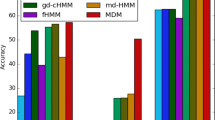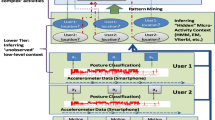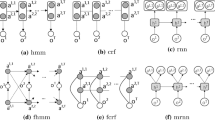Abstract
During last decade, smart homes in which the activities of the residents are monitored automatically have been developed and demonstrated. However, smart homes with multiple residents still remains an open challenge. In order to tackle the multiple resident concurrent activity recognition problem in smart homes equipped with interaction-based sensors and with multiple residents, we propose two different approaches. In the first approach, we use a factorial hidden Markov model for modeling two separate chains corresponding to two residents. Secondly, we use nonlinear Bayesian tracking for decomposing the observation space into the number of residents. As opposed to the previous studies, we handle multiple residents at the same time without assuming any explicit identification mechanisms. We perform two experiments on real-world multi-resident Activity Recognition with Ambient Sensing data sets. In each experiment, we compare the proposed approach with a counterpart method. We also compare each approach with the manually separated observation performances. We show that both of the proposed methods consistently outperform their counterparts in both houses of the data sets and for both residents. We also discuss the advantages and disadvantages of each approach in terms of run time complexity, flexibility and generalizability.














Similar content being viewed by others
References
Alemdar H, Ersoy C (2010) Wireless Sensor Networks for Healthcare: A Survey. Comp Networks 54(15):2688–2710
Alemdar H, Ertan H, Incel OD, Ersoy C (2013) ARAS Human Activity Datasets in Multiple Homes with Multiple Residents. In: 7th International Conference on Pervasive Computing Technologies for Healthcare, PervasiveHealth ’13, pp 232–235
Alemdar H, Tunca C, Ersoy C (2015) Daily life behaviour monitoring for health assessment using machine learning: bridging the gap between domains. Personal Ubiquitous Comp 19(2):303–315. doi:10.1007/s00779-014-0823-y
Arulampalam M, Maskell S, Gordon N, Clapp T (2002) A tutorial on particle filters for online nonlinear/non-Gaussian Bayesian tracking. IEEE Trans Signal Process 50(2):174–188
Benmansour A, Bouchachia A, Feham M (2015) Multioccupant activity recognition in pervasive smart home environments. ACM Comput Surv 48(3):34:1–34:36, 10.1145/2835372
Blackman SS (2004) Multiple hypothesis tracking for multiple target tracking. ieee aerosp. electr. syst. magaz. 19(1):5–18
Bulling A, Blanke U, Schiele B (2014) A Tutorial on Human Activity Recognition Using Body-worn Inertial Sensors. ACM Comp Surv 46(3):1–33
Chaquet JM, Carmona EJ, Fernández-Caballero A (2013) A survey of video datasets for human action and activity recognition. Comp Vision Image Underst 117(6):633–659. doi:10.1016/j.cviu.2013.01.013
Chen C, Liang J, Zhao H, Hu H, Tian J, Tian J (2009) Factorial HMM and Parallel HMM for Gait recognition. IEEE Trans Syst Man Cybern Part C: Appl Rev 39(1):114–123. doi:10.1109/TSMCC.2008.2001716
Chen L, Hoey J, Nugent CD, Cook DJ, Yu Z (2012) Sensor-based activity recognition. IEEE Trans Syst Man Cybern Part C Appl Rev 42(6):790–808
Chen R, Tong Y (2014) A two-stage method for solving multi-resident activity recognition in smart environments. Entropy 16(4):2184–2203
Crandall AS, Cook DJ (2009) Coping with multiple residents in a smart environment. J Ambient Intell Smart Environ 1(4):323–334
Deoras A, Hasegawa-Johnson M (2004) A Factorial HMM Approach to Simultaneous Recognition of Isolated Digits Spoken by Multiple Talkers on One Audio Channel. In: IEEE International Conference on Acoustics, Speech, and Signal Processing, ICASSP ’04 1:861–864. doi:10.1109/ICASSP.2004.1326122
Fahad LG, Khan A, Rajarajan M (2015) Activity recognition in smart homes with self verification of assignments. Neurocomputing 149, Part C:1286–1298
Ghahramani Z, Jordan MI (1997) Factorial hidden Markov Models. Mach Learn 273(29):245–273
Gordon N, Salmond D, Smith A (1993) Novel approach to nonlinear/non-Gaussian Bayesian state estimation. IEE Proceed F, Radar Signal Process 140(2):107–113
Guo P, Miao Z (2010) Multi-person Activity Recognition through Hierarchical and Observation Decomposed HMM. In: IEEE International Conference on Multimedia and Expo, ICME 10:143–148
Husmeier D (2005) Discriminating between rate heterogeneity and interspecific recombination in DNA sequence alignments with phylogenetic factorial hidden Markov Models. Bioinformatics 21(2):166–172
Incel O, Kose M, Ersoy C (2013) A review and taxonomy of activity recognition on mobile phones. Bionanoscience 3(2):145–171. doi:10.1007/s12668-013-0088-3
Jaward M, Mihaylova L, Canagarajah N, Bull D (2006) Multiple Object Tracking Using Particle Filters. In: 2006 IEEE Aerospace Conference. doi:10.1109/AERO.2006.1655926
van Kasteren T (2011) Activity Recognition for Health Monitoring Elderly Using Temporal Probabilistic Models. PhD thesis, University of Amsterdam, Netherlands
Kirubarajan T, Bar-Shalom Y (2004) Probabilistic data association techniques for target tracking in clutter. Proceedings of the IEEE 92(3):536–557
Lara O, Labrador M (2013) A survey on human activity recognition using wearable sensors. IEEE Commun Surveys Tutorials 15(3):1192–1209. doi:10.1109/SURV.2012.110112.00192
Moayedi F, Azimifar Z, Boostani R (2015) Structured sparse representation for human action recognition. Neurocomputing 161:38–46
Ordonez FJ, de Toledo P, Sanchis A (2013) Activity recognition using hybrid generative/discriminative models on home environments using binary sensors. Sensors 13(5):5460–5477. doi:10.3390/s130505460
Prossegger M, Bouchachia A (2014) Multi-resident activity recognition using incremental decision trees. In: Adaptive and Intelligent Systems, Springer, pp 182–191
Quesada FJ, Moya F, Medina J, Martínez L, Nugent C, Espinilla M (2015) Generation of a partitioned dataset with single, interleave and multioccupancy daily living activities. In: 9th International Conference on Ubiquitous Computing and Ambient Intelligence. Sensing, Processing, and Using Environmental Information, Puerto Varas, Chile, UCAmI 2015, pp 60–71
Roy N, Misra A, Cook D (2016) Ambient and smartphone sensor assisted adl recognition in multi-inhabitant smart environments. J Ambient Intell Humanized Comp 7(1):1–19. doi:10.1007/s12652-015-0294-7
Srinivasan V, Stankovic J, Whitehouse K (2010) Using height sensors for biometric identification in multi-resident homes. In: Pervasive computing, Springer, pp 337–354
Tapia EM, Intille SS, Larson K (2004) Activity Recognition in the Home Using Simple and Ubiquitous Sensors. In: International Conference on Pervasive Computing, Pervasive ’04, pp 158–175
Tolstikov A, Phua C, Biswas J, Huang W (2011) Multiple People Activity Recognition Using MHT over DBN. In: 9th International Conference on Smart Homes and Health Telematics, ICOST ’11, pp 313–318
Ward J, Lukowicz P, Gellersen H (2011) Performance Metrics for Activity Recognition. ACM Trans Inform Syst Technol 2(1)
Wilson DH, Atkeson C (2005) Simultaneous Tracking and Activity Recognition (STAR) Using Many Anonymous, Binary Sensors. In: Third International Conference on Pervasive Computing, Persuasive ’05, pp 62–79
Xu X, Tang J, Zhang X, Liu X, Zhang H, Qiu Y (2013) Exploring techniques for vision based human activity recognition: methods, systems, and evaluation. Sensors 13(2):1635–1650. doi:10.3390/s130201635
Acknowledgements
This work is supported by the Turkish State Planning Organization (DPT) under the TAM Project, Number 2007K120610 and by Bogazici University Research Fund (BAP) under the Grant Number 8684.
Author information
Authors and Affiliations
Corresponding author
Rights and permissions
About this article
Cite this article
Alemdar, H., Ersoy, C. Multi-resident activity tracking and recognition in smart environments. J Ambient Intell Human Comput 8, 513–529 (2017). https://doi.org/10.1007/s12652-016-0440-x
Received:
Accepted:
Published:
Issue Date:
DOI: https://doi.org/10.1007/s12652-016-0440-x




